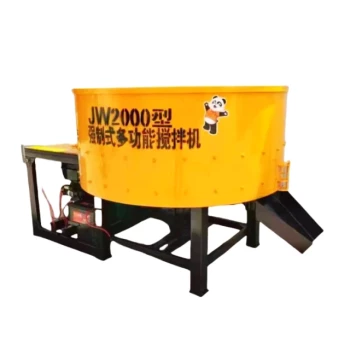When an abnormal situation is detected during the operation of a concrete mixer, the immediate priority is to ensure safety and prevent further damage. The mixer should be stopped right away to assess the issue. Once stopped, a thorough investigation should identify the root cause—whether it's mechanical failure, electrical issues, or operational errors. After resolving the problem, the mixer must be tested under controlled conditions to confirm normal operation before resuming full production. Key performance parameters, such as mixing time, discharge time, and overload capacity, should be monitored to ensure compliance with standards. Regular maintenance and operator training can help prevent future abnormalities.
Key Points Explained:
-
Immediate Shutdown
- The first step is to stop the concrete mixer to prevent further damage or safety hazards.
- Continuing operation during an abnormality can exacerbate mechanical failures or lead to unsafe conditions.
-
Investigation of the Issue
- Identify whether the problem is mechanical (e.g., worn-out blades, motor issues), electrical (e.g., wiring faults), or operational (e.g., incorrect loading).
- Check key performance metrics:
- Mixing homogeneity time (≤45 sec for forced mixers, ~50 sec for tilting drum mixers).
- Discharge time (should be <15 sec).
- Overload capacity (should handle 10% overload).
-
Resolution and Testing
- Repair or replace faulty components before restarting.
- Conduct a test run under partial load to verify normal operation.
- Ensure the mixer can restart normally after a 5-minute stop while fully loaded.
-
Preventive Measures
- Regular maintenance (e.g., lubrication, blade inspection) reduces the risk of abnormalities.
- Operator training ensures correct usage and early detection of issues.
-
Performance Verification
- Post-repair, confirm the mixer meets all operational benchmarks before resuming full production.
- Monitor for recurring issues to address underlying problems.
By following these steps, you can minimize downtime, extend equipment lifespan, and maintain consistent concrete quality. Have you considered integrating automated monitoring systems to detect abnormalities early? Such technologies can quietly enhance efficiency in construction workflows.
Summary Table:
| Step | Action | Key Metrics |
|---|---|---|
| Immediate Shutdown | Stop the mixer to prevent damage or hazards. | N/A |
| Investigation | Identify mechanical, electrical, or operational causes. | - Mixing time (≤45 sec forced; ~50 sec tilting) - Discharge time (<15 sec) - Overload capacity (10%) |
| Resolution | Repair/replace faulty parts; test under partial load. | Verify normal restart after 5-minute full-load stop. |
| Prevention | Schedule maintenance (lubrication, blade checks) and train operators. | N/A |
| Verification | Confirm benchmarks post-repair before full production. | Monitor for recurring issues. |
Facing concrete mixer issues? GARLWAY specializes in durable construction machinery, including high-performance concrete mixers designed to minimize downtime. Our global clients trust us for reliable equipment and expert support. Contact us today for tailored solutions—let’s keep your project on track!
Related Products
- Ready Mixer Machine for Construction Ready Mix Machinery
- Commercial Construction Mixer Machine for Soil Cement Mixing Concrete
- Auto Concrete Cement Mixer Machine New
- Construction Products Concrete Plant Machine Mixing Concrete Mixer
- JDC350 Small Cement Concrete Mortar Mixer
People Also Ask
- How does concrete not harden in a truck? The Science Behind Workable Concrete
- What factors to consider when selecting type of concrete mixer? Essential Guide for Optimal Performance
- How do you maintain a concrete mixer? Essential Tips for Longevity & Performance
- How to choose the right concrete mix? Key Factors for Strength & Durability
- Are there different types of concrete mix? Explore Varieties for Optimal Construction













